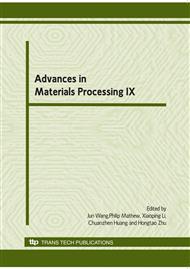p.537
p.543
p.551
p.557
p.562
p.567
p.573
p.582
p.588
FEA-Predicted Subsurface Damage in Micro Finishing of a Feldspar Porcelain Using Fine-Grit Dental Burs
Abstract:
Biocompatible ceramic structures are used to replace missing teeth, tooth structure lost to disease or trauma, and un-aesthetic healthy, tooth enamel. Recreating aesthetics and function are the two practical goals of such restorative treatment. However, the failure rate of ceramic prostheses is relatively high due to their inherent brittleness. A primary reason to premature failure of ceramic prostheses is surface and subsurface damage induced in dental intraoral finishing using dental handpieces and abrasive burs. In this paper, finite element analysis (FEA) was applied to predict quantitatively finishing-induced stress fields and subsurface damage depths in dental porcelain surfaces using fine grit diamond burs. The results indicate that while finishing using fine diamond burs diminished subsurface damage, damage depths of smaller than 20 m remained depending on the bur depth of cut and feed rate. In the FEA modeling, the minimum damage was obtained under very fine finishing conditions.
Info:
Periodical:
Pages:
562-566
Citation:
Online since:
June 2010
Authors:
Price:
Сopyright:
© 2010 Trans Tech Publications Ltd. All Rights Reserved
Share:
Citation:


